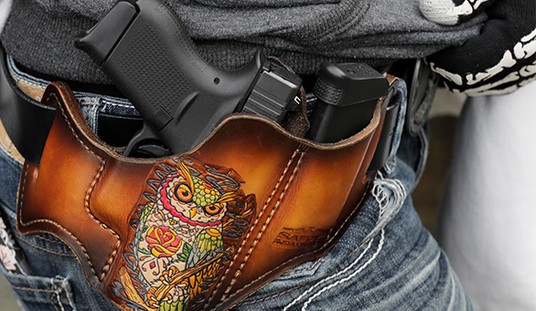As the fear of COVID-19 kicked off, a gun-buying frenzy also began. Based on what we’re hearing from gun stores all over the nation, the majority of these gun buyers were first-time gun owners. They were people who didn’t have a gun but suddenly felt like they needed something for protection.
If you are one of those first-time gun owners, welcome. We here at Bearing Arms feel you made the right choice. Guns are the ultimate equalizer. They allow even the frailest among us to take on stronger, more aggressive attackers in a way that minimizes the threat to ourselves.
We at Bearing Arms want to help you. You see, guns are tools that, if not used properly, can hurt or kill innocent people. This isn’t any different than pretty much any kind of power tool out there, so don’t get worried. All you need is some proper training on how to use them properly.
As with most other tools–and yes, a firearm is a tool–there are some basic rules you should follow to keep you and yours safe and sound. We call these the Four Rules of Gun Safety, and they’re rules that pretty much every gun owner is expected to follow. Originally coined by Col. Jeff Cooper, they’re not the mainstay for the firearm community.
1. Treat All Weapons As If They Are Loaded
There are a lot of stories about people being shot with supposedly unloaded firearms. They think they’re unloaded but maybe there’s a round in the chamber or something else. It doesn’t matter. Always assume the weapon is loaded.
When you accept a gun from someone, you check the chamber. You then proceed to treat it like it’s a loaded weapon. That means you don’t play around with it.
The truth is, the potential cost for treating an unloaded gun is non-existent, but what’s the cost for treating a loaded gun as if it’s loaded? That can be downright catastrophic. So don’t.
2. Never Point Your Weapon At Anything You Don’t Intend To Destroy
If you don’t want to shoot it, don’t point your gun at it. Period. Remember, your weapon is loaded even if it’s not. You treat it like a loaded gun, so you don’t point a loaded weapon at anything you don’t want to shoot.
Pointing at a target? That’s fine.
Pointing at your cat? Not so much.
Pointing at the guy who just broke into your home? Go you!
Pointing it at your spouse because you think it’s funny? STOP THAT RIGHT NOW!
Seriously, this isn’t rocket science.
3. Keep Your Finger Off The Trigger Until You’re Ready To Fire
Guns don’t just discharge on their own. You may have heard someone claim otherwise, but that’s not true. They may not know why it went off, but except for a malfunctioning weapon, it went off because something pulled the trigger.
As a result, you need to keep your finger off the trigger. I like to phrase it as, “Keep your booger-hook off the bang-switch.” Regardless, it’s the same principle. A finger sitting on a trigger has the potential to pull the trigger. Maybe you’re startled. Maybe you trip. There are a number of situations where you may involuntarily “pull” with your finger. If that finger isn’t on the trigger, then that trigger doesn’t get pulled when you didn’t mean for it to.
4. Be Sure Of Your Target And What’s Beyond It
What are you shooting at? Is that a burglar? Or is it your spouse up to get a late-night snack? It might be your teen sneaking back in after curfew. While you might want to ground him or her, you probably don’t want to shoot them.
As a result, you need to be sure of your target.
Not just that, though, but you need to know what is beyond it. After all, you may be quite sure of that paper target actually being a paper target, but what’s beyond that target? If you’re at a proper outdoor range, it might be a tightly-packed earthen berm. An indoor range will have some other kind of barrier.
Regardless, you need to know that your round won’t go beyond your target and create still more carnage. Bullets, you see, are notorious for not really caring about what you want to hit or not. They’re just going to keep going until they run out of energy. In a perfect world, they’d run out of energy the precise moment they’d accomplished what you want them to accomplish. However, we don’t have a perfect world, we have this one.
Instead, bullets keep going. That may be miles away in some cases.
In other cases, though, it might just be inside someone you care about, so make sure know what you’re pointing your weapon and what else might get hit before the round comes to a stop.
Now, those are the Four Rules. Now you’re all finished, right?
WRONG!
The truth is, you’re never done learning. Firearm use is an ongoing process of constant training. This is just the beginning and it’s a very basic beginning at that. You need a lot more training than this.
A good first step is to look into the National Rifle Association’s classes. They’re offering a number of them online right now due to the COVID-19 pandemic, so it might be worth a look.
Also, check out the National Shooting Sports Foundation’s list of rules. You’ll find some familiar rules here, but they also have some others that are all solid rules to live by as well.
The United States Concealed Carry Association is another group that offers firearm classes.
None of this should deter you from talking to your local gun store about who they recommend in your neck of the woods for training. I’m sure they know someone they can recommend, so feel free to ask them.
Right now, a lot is going on and we know you purchased your firearm because you’re concerned. Again, we think you made the right call. Just understand that there’s a lot to learn. Having a gun doesn’t make you into a badass, it simply makes you armed. Armed and ignorant is a recipe for disaster, so check out the above links and keep checking back here at Bearing Arms where we’ll try and offer more training tips as we’re able.








Join the conversation as a VIP Member